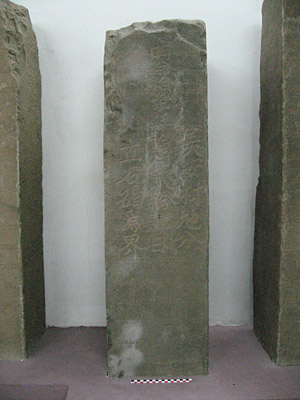Corpus of the Inscriptions of Campā




C. 7 Doorjamb from Lamngâ
Please note: you are reviewing a preprint version of this publication. Contents here may change significantly in future versions. Scholars with specific interests are urged to consult all cited bibliography before using our texts and translations or drawing other significant conclusions.
Text Two texts; the first covering four, the second eleven, for a total of fifteen lines on one face; both texts written in Old Cam.
Date End of the 12th century Śaka (13th century CE).
Origin Settlement of Lamngâ (Ninh Thuân, Vietnam).
This doorjamb was found before 1888, when it was first mentioned in the literature, by Bergaigne 1888: 92. This author informs us that it was found “à l'embouchure de la rivière de Phanrang. La stèle avait été transportée là pour servir de borne entre deux villages. Depuis, elle a été enlevée par les missionnaires qui l'ont placée dans la chrétienté”. Between the end of the 19th century and the first decade of the 20th century, it was observed at the Phan Rang residence (Parmentier 1909: 79-81). Like the architectural elements bearing C. 3, C. 4, C. 5 and C. 6, this one was later identified as belonging to a group of vestiges, found in the rice-fields of the Catholic Mission, to which the designation “sanctuaire de Svayamutpanna” was applied (Parmentier 1918: 77). When the inscriptions of Campā were moved from the Saigon Museum to the EFEO Museum in Hanoi in 1910, the collection was completed by other inscriptions regarded as being of outstanding importance for the history of Campā. The doorjamb bearing C. 7 was one of them (Finot 1915a: 2). Its inventory number B 2, 14 at the Museum was published in Finot 1915a: 10; whence, in the inventory of Campā inscriptions published in 1923, this local number was included under the entry C. 7 (Cœdès 1923). We identified the stone in the Bảo Tàng Lịch Sử Việt Nam (National Museum of Vietnamese History) at Hanoi in 2009 and following years, as the one bearing inventory number LSb 21167. The Museum assumed the new name Bảo Tàng Lịch Sử Quốc Gia (National Museum of History) in 2011, but this did not entail a change in the inventory number.
Edition(s) A few words were read in Bergaigne 1888: 192; some more in Aymonier 1891: 52-53; partially summarised in English, in Majumdar 1927: 209, whence Golzio 2004: 183. It was studied in Jacques 1977-1978: 1079-1080 but was integrally published for the first time in ECIC IV: forthcoming, which publication is reproduced here.
Facsimiles
- Estampage: BnF 392 (44)
- Estampage: EFEO 5
- Estampage: EFEO n. 142
The following text was edited by Arlo Griffiths and Amandine Lepoutre.
1 [jāk· ṅan·] ◇ this restitution is based on the analysis of the term tandoṅ laṅguv (see note in ECIC IV: forthcoming). — 4 [#]3 drim̃ ◇ the fact that five ethnic groups are nammed in the previous line suggests that another digit needs to be restored in front of the figure 3. — 7 pā(k·) ◇ rok Aymonier. — 8 śiśī [bh](ū) ◇ read śaśī bhū. — 12-13 mula ◇ read mūla. — 13 rumaḥ gaḥ ◇ ruma nagara Bergaigne.
Translations
English
... jāk with tamdom̃ laṅguv.
Gold as property: 30 thil; silver as property: 300 thil;
Khmers, Javanese, Chinese (?), Paganese, Siamese: #3 persons. Family of mauk Madrim̃: 4 persons; of mauk Vuṅā...
... Y.P.K. Śrī Jaya Parameśvaravarmadeva went out [in order to] go and divide up ... Y.P.K. Śrī Campeśvara. He offered ... made good dams, cleaned the canals of Śrī VīraCuk's rice-fields in this Śaka [year] ..., (1) moon, (1) earth (i.e. in 11## Śaka) this rice-field [is] a unit offered to Y.P.K. Svayamutpanna and Y.P.K. Śrīpatīśvara [delimited] on the Eastern side by the ramp; on the Southern side gnam̃ḥ pyā river by the rice-fields of the country; on the Southern side by P.L. Iśānavarman's rice-fields, the gods' rice-fields, the rice-fields [constituting] the capital; on the Western side by the rice-fields near the edifices; on the Northern side by the great canal; three atam̃ danrāk; 500 jāk with tandom̃ laṅguv [of] uneven [lands].
French
... jāk avec tamdom̃ laṅguv
De l'or pour les biens : 30 thil ; de l'argent pour les biens : 300 thil ;
Des Khmers, des Javanais, des Chinois (?), des Paganais, des Siamois : #3 personnes. Famille de mauk Madrim̃ : 4 personnes ; de mauk Vuṅā...
... Y.P.K. Śrī Jaya Parameśvaravarmadeva sortit [pour] aller diviser ... Y.P.K. Śrī Campeśvara. Il offrit ... fit de bons barrages, cura les canaux pour les rizières de Śrī VīraCuk en cette [année] Śaka 11## (##, 1 [lune], 1 [terre]) cette rizière [est] un emplacement offert à Y.P.K. Svayamutpanna et Y.P.K. Śrīpatīśvara [délimitée] du côté est par la dénivéllation ; du côté sud gnam̃ḥ pyā fleuve par les rizières du pays ; du côté sud par les rizières du P.L. Iśānavarman, les rizières des dieux, les rizières [constituant] le capital ; du côté ouest par les rizières près des édifices ; du côté nord par le grand canal ; trois atam̃ danrāk ; 500 jāk avec tandom̃ laṅguv [de terres] dénivelées.
Commentary
Secondary Bibliography
- Parmentier 1909: 79-81.
- Finot 1915a: 2 and 10.
- Parmentier 1918: 77.
- Griffiths & Lepoutre 2013: forthcoming.
The term laum̃ (= lauv or lov, also occuring in C. 30 B1) is recorded in the available dictionaries and translated there as 'Chinese'. However, it it possible that, originally, this word (identical to the Thai word used to name the modern state of Laos) suggests Thai-speaking populations. The possibility that the term lauv used in these inscriptions could designate a Lao population should be kept in mind.